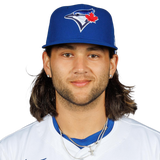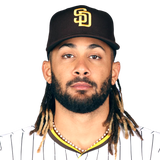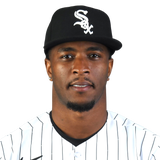
There's no question that shortstop is the deepest position in Fantasy Baseball in 2023, at least if you're talking about impact players. There are a whopping 13 shortstop-eligible players with an ADP inside of the top-100 in NFBC drafts right now, more than any other offensive position besides outfield, which obviously has many more positions to fill in your standard Fantasy lineup.The other infield positions only have between six and eight top-100 players!
And for the most part, I can't really disagree with the order the high-end shortstops are going off the board:
- Trea Turner (2.83 ADP)
- Bobby Witt Jr. (9.61)
- Bo Bichette (14.79)
- Fernando Tatis Jr. (18.56)
- Francisco Lindor (32.63)
- Corey Seager (58.36)
- Oneil Cruz (69.45)
- Tommy Edman (73.43)
- Dansby Swanson (77.27)
- Wander Franco (85.9)
- Xander Bogaerts (86.49)
- Tim Anderson (88.63)
- Willy Adames (94.28)
I might quibble with the order a bit, sure. I have Tatis as the No. 2 player at the position and Bichette No. 3, with Witt falling to fourth for me. But he's still a top-20 player, so I'm hardly burying Witt here.
Similarly, I have Cruz ranked a bit higher than Edman, and I prefer Bogaerts to Swanson; I've also got Franco a bit lower than the consensus, as my No. 12 SS, though again, he's still a top-90 pic, so I'm not that much lower.
The one place I really do disagree with the consensus is on the No. 14 SS. At NFBC, that is Jeremy Pena of the Astros, who sports an ADP of 111.77. For me it's Carlos Correa, who I rank 90th overall in Roto leagues – his ADP is way down at 117.84. What's going on with that gap?
First off, it's worth noting that Pena was better than Correa last season, ranking as the 103rd player in Roto scoring, compared to 104 for Correa. Both played 136 games, so it makes sense to rank them near one another, and with Pena a better bet for steals, you can see the case for preferring him, especially since he's a young player who was making his MLB debut. He'll surely be better in Year 2, right?

Fantasy Baseball Draft Kit
Your ultimate baseball draft guide
Dominate your Fantasy Baseball draft with our free Draft Kit, which gives you must-have positional and Top 300 rankings in a printable format. Plus track your draft with our lineup builder and salary cap tracker.
Thanks for signing up!
Keep an eye on your inbox.
Sorry!
There was an error processing your subscription.
Possibly, though I feel a lot more confident in Correa taking a step forward, personally. For one, he was just a better hitter, sporting a .291/.366/.467 line compared to Pena's .253/.289/.426 mark. And Correa played right to his expected stats, per BaseballSavant.com, while Pena actually outpaced his by a small amount. Not enough to expect huge regression, especially given his home park, but enough that I'm not necessarily penciling in a big step forward.
But the biggest case for Correa being ranked ahead of Pena is that I do think you can project Correa to be better in 2023 than he was, mostly in the run production categories. Correa's 70 runs and 64 RBI are a shockingly low number for a hitter of his quality, especially in a Twins lineup that was pretty middle of the road overall. He had 104 runs and 92 RBI the prior year in Houston while posting an identical OBP and only four more home runs in 12 more games. Sure, Houston's was a better lineup, but when you look around the league, Correa's numbers still seem wildly out of proportion; Andrew McCutchen hit .237/.316/.384 with 17 homers on a similarly middling Brewers team and had 66 runs and 69 RBI in 134 games, for example.
Correa will almost certainly up his counting stats in 2023, and while there's little hope of him becoming a base stealer again, he seems like a pretty good bet for strong four-category contributions in my eyes. Of course, there's the elephant in the room, the ankle issue that led to not one but two voided contracts in free agency and ultimately landed Correa back in Minnesota on a discounted (relatively) deal). That was enough to scare off the Giants and Mets, and it seems likely to be scaring off at least a few Fantasy players.
I'm not a doctor, so I won't say the doctors who failed his physical were wrong to do so. However, per ProSportsTransactions.com, Correa hasn't missed a game with an ankle injury since 2016, so while it may be a concern for a 10-year mega contract, I'm not sure how much we should be worried about it for 2023. Maybe it's a ticking time bomb ready to explode, but I'm not really factoring it in. Correa is a clear value at his price, one of the best out there at a position without them.
The depth at shortstop kind of runs out after Correa, too. Amed Rosario (123.59) and Nico Hoerner (139.62) are fine bets for some steals and average, but neither is an impact bat; Javier Baez (166.28) could be, but he has a lot of work to do to regain our trust after a pretty disastrous first season in Detroit. And after that, Thairo Estrada is the only other shortstop with an ADP inside of the top 230; amazingly, there are actually more second basemen inside the top 230.
Which is to say, shortstop is a very deep position for impact players, and if you end up with a SS in your MI and UT spots, it's probably not a bad thing. If you're aggressive, of course. If you decide to wait on the position, you might find yourself running out of options sooner than you expect to, especially in a 15-team league. Be careful.
Turner might slow down as a base stealer at some point, and it might be tough to justify him as a first-round pick when that happens. But at his current level of production, he's one of the few true five-category contributors, and the move to Philadelphia this offseason shouldn't cost him much value at all. He's a viable No. 1 overall pick.
| ||||||||||||||||||||||
Bichette got off to a miserable start, sporting just a .535 OPS in April, but his numbers more or less ended up where we expected them to be by the end of the season. The counting stats were still pretty disappointing, but when you're talking about 184 combined runs and RBI being "disappointing," you're talking about a pretty special player. Bichette is another five-category contributor, albeit one who probably trails Turner across the board.
| ||||||||||||||||||||||
Tatis lost all of last season to shoulder and wrist surgeries plus a PED suspension he will still be serving through April 20 to begin this season. He carries a ton of volatility, between injury risk and concerns about how he'll look coming off the suspension and injuries, but he also very well could be the top player in Fantasy despite missing multiple weeks. Don't believe me? He was the No. 5 overall player in 2021, hitting .282-99-42-97-25 in just 130 games. There might not be another player with as much five-category upside.
| ||||||||||||||||||||||
We're hoping Witt turns into a Tatis-type player, and someone may pick him in the first round chasing that upside. He's got a long way to go before he's worth that kind of price, though he was the No. 36 pick in Roto leagues as a rookie despite not being close to a finished product yet. He probably deserves to go at least a few spots lower in H2H points leagues than this.
| ||||||||||||||||||||||
Lindor had a nice bounceback season in his second with the Mets, re-emerging as a true five-category contributor in an elite offense. That offense should continue to provide him with a ton of run production opportunities, though it's worth noting that his expected stats didn't quite support his production last season – in fact, his expected wOBA was a bit higher in 2021, despite the worse surface numbers. A step back wouldn't shock me, but he should still be very good.
| ||||||||||||||||||||||
Seager looked like an elite bat in 2020 and 2021, albeit in just 52 and 95 games. Still, I think he can get back to that level, and the underlying numbers are on my side: Only four hitters in 2022 underperformed their expected wOBA by more than Seager, per Statcast. He hits the ball hard consistently, he has excellent plate discipline, and hits a ton of line drives, which are all things we tend to think are pretty good for hitters. The shift limitations will help Seager, too. A .300 average and 30-plus homers are well within the realm of possibility for Seager.
| ||||||||||||||||||||||
For the first time in the Statcast era (going back to 2015), a player not named Giancarlo Stanton had the hardest hit ball in the majors last season. It was Cruz, and that should tell you just about everything you need to know about what kind of upside we're dealing with here. Of course, he also couldn't hit lefties and struck out in 35% of his plate appearances, so there are glaring red flags here, too. He's probably the most high-variance player at the position – his ceiling might be even higher than Witt's, and his flaws might be even larger.
| ||||||||||||||||||||||
If you draft Edman, it's probably as a second baseman. When Edman hit three homers in his first six games, there was some hope that he might have taken a bit of a step forward. That didn't come to pass, but it didn't really matter, because his final numbers ended up pretty much where they were the prior season. There probably isn't a ton of room for him to improve from here, but Edman is an efficient and enthusiastic base stealer who isn't a zero with the bat. He's kind of a two-and-a-half category contributor, but that's enough.
| ||||||||||||||||||||||
Swanson took a big step forward in 2022, just in time for free agency, but it was more on the defensive side of things – his production on offense wasn't that far off from where he'd been the previous few seasons. The biggest change came with Swanson attempting a career-high 25 steals and seeing a spike in run production, largely because he was hitting higher in the order than usual. Both could carry over in 2023 with the Cubs, and while I doubt he repeats his .277 average, there's not much from last season that looks flukey.
| ||||||||||||||||||||||
Bogaerts is a weird player. He's consistently a very good Fantasy option, but he has little year-to-year consistency. He took a step backward last season, but I think a lot of that was due to the lineup he was in. Bogaerts is in a very good Padres lineup now, and counting stats should be plentiful, even if he's more of a 15-to-20 homer guy now.
| ||||||||||||||||||||||
Anderson hasn't played a full season since 2018, and that's the primary case against him at this point. He took a step back as a power hitter last season, though the underlying numbers suggest that was more bad luck than anything else, and his full-season pace would still have given him 12 homers and 26 steals. The injury risk scares some folks off, but with a bit better luck, Anderson could pretty easily perform like one of the high-end options at the position. Just take the discount and say "thank you."
| ||||||||||||||||||||||
Franco isn't the superstar we all hoped he would be yet, but he's still just 21 and has some obvious elite skills, most notably his contact abilities. His overall batted ball profile remains weak, but Franco's max exit velocity did leap to 112.4 mph, a well-above average number that gives hope he can take a step forward as a power hitter. If not, he should still be good for double-digit homers and steals with a very good average, but there's room to grow beyond that, too.
| ||||||||||||||||||||||
Correa's free agency saga alerted us to an unknown (to us) ankle issue that blew up deals with the Giants and Mets before he ultimately returned to the Twins. There's obviously some injury risk here, though it sounds like the ankle is more of a long-term concern than something likely to fail him in 2023. He's stayed pretty healthy the past three years and has settled in as a solid mid-.800s OPS bat after a few down years. The counting stats were weirdly down last season, but if Correa hits like he did, I don't have much concern about that being an issue moving forward. Correa is a strong value at this point.
| ||||||||||||||||||||||
Hoerner is fairly limited as a hitter, but what he does, he does really well. He won't hit for much power, but he's going to be a good source of batting average thanks to a contact-forward approach and a lot of line drives, and his 92nd percentile sprint speed should make his 20 steals from last season more of a floor. With a better Cubs lineup around him, Hoerner should score a decent amount of runs, too, making him potentially a very good three-category contributor.
| ||||||||||||||||||||||
Mondesi has played just 50 games over the past two seasons and has basically never played a full season in his professional career, so we'd expect him to miss some time even in a best-case scenario. However, Mondesi is still rehabbing from surgery to repair his torn ACL suffered last April and may not even be ready for the start of the season at this point. When he's healthy, Mondesi is the best base stealer in the game, but he may not play everyday for the Red Sox anyway. This is a boom-or-bust profile, but at this point, it's not even clear how much boom is left.
| ||||||||||||||||||||||
The primary thing Stott has going for him at this point is that he's a young recent top prospect. He's pretty athletic (91st percentile sprint speed) and makes a decent amount of contact (62nd percentile strikeout rate), but his quality of contact was so poor that it's not clear where the upside is supposed to come from. He could take a step forward as a 25-year-old, but Stott is much more of a fallback option even as a middle infielder.
| ||||||||||||||||||||||
Garcia showed flashes of improvement, and I'm still intrigued by his skill set despite pretty disappointing production so far – remember, he was just 20 when he made his debut in 2020, so he won't be 23 until mid-May despite 203 games over three MLB seasons. He's shown plus raw power, including a max exit velocity of 113.4 mph last season, in the 91st percentile of all hitters. The problem was consistency, as his hard-hit rate was just 36.7%. Garcia needs to hit because he won't provide much value as a base stealer, but if I'm throwing a late-round dart for my bench, he's on the list.
| ||||||||||||||||||||||
Abrams hasn't shown very much at the major-league level, hitting just .247/.280/.324 in 90 games last season, but it's important to remember the context of that. He has played just 204 games total as a professional, moving up to the majors after just 80 games between Double-A and Triple-A. He'll be 22 on Opening Day and was a top-12 consensus prospect a year ago, so I'm not giving up on the talent. He's been thrust into some extremely difficult situations, but the minor-league track production is still very strong, and he should be an asset in steals even in an environment where they are more plentiful league wide. Abrams could still be a difference maker, and he doesn't cost much at all.
| ||||||||||||||||||||||
Cruz put up a 30-homer pace as a rookie despite struggling to make contact and flailing against most of the left-handed pitchers he saw, so it's not unreasonable to suggest he could be a 40-plus homer guy in the long run. Or he might continue to strike out at a 35% clip, be a drain on your batting average, and become a platoon player. He's an incredibly high variance player, but the high end outcomes would put him in the first round range pretty easily. If you're going to take a big swing, it might as well be at a position where you shouldn't have much trouble finding a fill-in if he flops. Though, the nice thing is, even if Cruz's flaws hold him back, the tools are still so loud that he should be useful for the power/speed combination.
| ||||||||||||||||||||||
A lot of what I said about Cruz also goes for Witt, who was a top-36 player in Roto leagues last season despite some pretty big holes in his game. Why is one a breakout pick and one is a bust? It's all about price – in NFC leagues, Witt's ADP is 8.35 while Cruz's is 74.01. Witt is a better player right now, with better contact skills and likely an edge in steals, and I am in no way trying to argue they should be drafted anywhere near each other. Witt is a much more sure thing, and if I can grab him in the late second round, I'm fine with him. But if it's going to cost a first-round pick, Witt has too much risk to justify the cost.
| ||||||||||||||||||||||
Shortstop Top Prospects
1. Anthony Volpe, SS, Yankees
Age (on opening day): 21
Where he played in 2022: Double-A, Triple-A
Minor-league stats: .249 BA (511 AB), 21 HR, 50 SB, .802 OPS, 65 BB, 118 K
Before you nitpick Volpe's batting average, note that he needed some time to adjust to the wider variety of pitches at Double-A, batting .286 with a .910 OPS in his final 72 games there. He's moved quickly in two years, maximizing his launch angle for power and tearing up the base paths more on instincts than pure speed (which makes it more likely to translate, probably).
Scott's 2023 Fantasy impact: fighting this spring
2. Elly De La Cruz, SS, Reds
Age (on opening day): 21
Where he played in 2022: High-A, Double-A
Minor-league stats: .304 BA (471 AB), 28 HR, 47 SB, .945 OPS, 40 BB, 158 K
The name De La Cruz is fitting for someone who's basically the sequel to Oneil Cruz -- i.e., a freakishly tall shortstop (6-foot-5 in this case) with an equally freakish tool set. But while strikeouts didn't become an issue for Cruz until the majors, they're already excessive for De La Cruz ... not that it's mattered yet. I'm inclined to bet on players who make it work at Double-A, as he has.
Scott's 2023 Fantasy impact: midseason hopeful
3. Jordan Lawlar, SS, Diamondbacks
Age (on opening day): 20
Where he played in 2022: Rookie, Low-A, High-A, Double-A
Minor-league stats: .303 BA (389 AB), 16 HR, 39 SB, .910 OPS, 57 BB, 115 K
The sixth pick in the 2021 draft is now the highest ranked of his class despite having already had to contend with a torn shoulder labrum, a benign back growth and a fractured scapula. His strikeout rate has crept into uncomfortable territory as he's moved up the ladder, but for a five-category talent who's moved as quickly as he has, it's forgivable.
Scott's 2023 Fantasy impact: late-season look
4. Marcelo Mayer, SS, Red Sox
Age (on opening day): 20
Where he played in 2022: Low-A, High-A
Minor-league stats: .280 BA (350 AB), 13 HR, 17 SB, .887 OPS, 68 BB, 107 K
Considered by many to be the top talent in the 2021 draft, Mayer's polish is evident, and he should have a relatively easy and straightforward climb to the majors. Corey Seager remains the go-to comp, with an expectation Mayer will hit for both average and power from the left side of the plate, and it's possible he turns out to be more of a base-stealer than expected.
Scott's 2023 Fantasy impact: don't count on it
5. Jackson Holliday, SS, Orioles
Age (on opening day): 19
Where he played in 2022: Rookie, Low-A
Minor-league stats: .297 BA (64 AB), 1 HR, 4 SB, .911 OPS, 25 BB, 12 K
Another son of a multi-time All-Star (Rockies and Cardinals great Matt Holliday), Holliday was the one player drafted ahead of Jones last year, and while the tools aren't as tantalizing, the skills set him apart from other 19-year-olds. He profiles much like his father offensively, projecting for easy batting average with an advanced approach and tremendous barrel control, only from the left side and at a more premium position.
Scott's 2023 Fantasy impact: don't count on it






















































